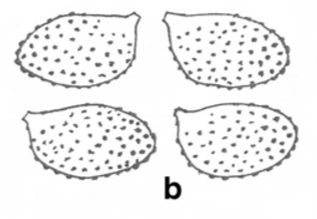Cortinarius ochroamarus Niskanen, Kytöv. & Liimat
Index Fungorum number: IF551438 Facesoffungi number: FoF00998
Etymology: The name refers to the ochraceous colour of the pileus and the bitter taste.
Holotype: T. Niskanen 04-761, H6030006 (H). Pileus 20–60 mm, hemispherical, then low convex, ochraceous yellow to yellow, sometime more yellowish red brown when moist, viscid, with hygrophanous streaks. Lamellae almost crowded, adnexed to emarginated, very pale brown, later pale brown. Stipe 40–80 mm long, 4– 8 mm thick at apex, 6–13 mm at base, somewhat clavate, white, almost dry. Universal veil viscid. Context in pileus and upper part of the stipe pale yellow, white to pale yellow at the base of the stipe marbled hygrophanous. Odor of flesh sweetish, pleasant. Taste very bitter at least of the pileus surface. Basidia 4-spored. Basidiospores 7– 8.4×4.5–5.4 μm (av. = 7.7×5 μm, 120 spores, 3 specimens), Q=1.44–1.67 (av. = 1.54), amygdaloid-ellipsoid, finely to fairly strongly verrucose, most strongly at apex, fairly weakly dextrinoid. Lamellar trama hyphae smooth, often somewhat granulose, yellow in Melzer’s reagent. Pileipellis. Hyphae in the surface layer narrow, 2–4 μm wide, hyaline, embedded in mucus. Hyphae under the surface layer 5–15 μm wide, pale yellow in Melzer’s reagent, not encrusted. ITS sequence (GenBank KR011132, holotype) distinct from the other known members of the section Vibratiles, and differing from them it in the ITS region by more than 10 substitutions and indel positions. Ecology and distribution. In herb-rich, mossy Picea abiesdominated forests on calcareous ground. Producing basidiomata in late summer and autumn. Rare to occasional, known from Northern Europe.
Material examined: FINLAND, Uusimaa, Espoo, Luukkaa outdoor recreation area, N of Hauklampi, nature reserve area, mesic, partly grass-herb spruce forest (Picea abies) with some Populus tremula, Betula and Pinus sylvestris, 9 September 2004, leg. K. Liimatainen & T. Niskanen 04-761, H6030006 (holotype, H), (isotype, NY). Varsinais-Suomi, Karjaa, Mustio, Kohagen, herb-rich Picea abies forest with some Corylus avellana, Quercus robur, Betula and Populus tremula, or under Populus tremula, 2 September 2008, leg. K. Liimatainen & T. Niskanen 08-045, H6001939 (H). SWEDEN, Jämtland, Östersund, Böle, Fillstabäcken, damp to submesic coniferous forest (Picea, Pinus) on calcareous ground, 2 September 2003, leg. I. Kytövuori, K. Liimatainen & T. Niskanen 03-1065, H7018099 (H).
Notes: Cortinarius ochroamarus belongs to /Vibratiles. Typical for the species of this clade are viscid to glutinous pileus, almost dry to glutinous stipe, and bitter taste. Cortinarius ochroamarus is best recognized by the combination of ochraceous yellow pileus, almost dry stipe, amygdaloid-ellipsoid spores, and habitat on calcareous soils. The species is most similar to C. vibratilis (Fr.: Fr.) Fr. sensu Moser and of Kytövuori & Niskanen, but C. vibratilis has a saturated apricot yellow to yellowish red brown pileus, somewhat narrower spores, 7–8×4.3– 4.8 μm, and it occurs on more acid soils. Large basidiomata of C. ochroamarus can even resemble species of /Multiformes, but those have a clavate to bulbous stipe base, mild taste, and larger spores, over 8 μm long.


